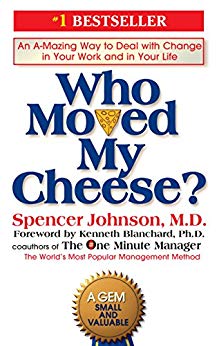

This article is an excerpt from the Shortform summary of "Who Moved My Cheese" by Spencer Johnson. Shortform has the world's best summaries of books you should be reading.
Like this article? Sign up for a free trial here .
A common change in many people’s lives involves their jobs. Jobs and careers aren’t static. If your job is redefined or eliminated, applying the principles in Who Moved My Cheese can help you with dealing with change at work successfully.
We’ll cover the seven steps of successfully dealing with change in the workplace, including examples of each of the steps. Learning how to deal with change at work can be hard, but it’s an essential skill to develop, and these strategies from Who Moved My Cheese are the secret.
Coping with Change at Work
Step #1
To start with, watch for change by paying attention to company statements, workload and structural changes, and industry trends. If you sniff out change, you can prepare for change by getting your personal finances in order, adding a part-time job, learning a new skill to develop your job in a different direction, or moving to a new company. This is crucial for dealing with change at work.
Step #2
Don’t try to hold on to the past (don’t wait for the cheese to reappear) by ignoring warning signs, resisting new skill requirements, or by just working harder at what you know. Changing work can be scary, and it’s tempting to be in denial, but the longer you do this, the more you hurt yourself, and the worse you because at coping with change at work.
Step #3
To combat the fear and learn how to deal with change at work, envision something better (picture new cheese) — this can be an opportunity to do something you’ve always wanted to do, but couldn’t because the job tied you down. Now that you’re free of old constraints, imagine yourself succeeding in a new role. Focus on what you can gain through change rather than what you might lose. Possibilities include a chance to use latent creativity in a different job, having new experiences, or moving to a different part of the world.
Step #4
Don’t let fear paralyze or hold you back from trying something new, whether it’s learning a new skill at the same company, or doing something different. Don’t be afraid to leave your comfort zone, because doing something offers a better chance of success than doing nothing. If you don’t move quickly to adapt you may lose your best chance. For instance, others will learn new skills and fill jobs that could have been yours.
Step #5
Learn to enjoy change — it can offer rewards such as greater income, new relationships, or greater job satisfaction from using more of your talents. Seeing the bright side is critical for dealing with change in the workplace. Finally, expect and prepare for continuous change by always growing and learning in your personal and professional life.
The moral of the cheese story is that the end of the old can also be the beginning of something better. This reminder is the key to dealing with change at work.
How to Deal with Change at Work and in Life
These are the lessons applied more generally, not just for dealing with change in the workplace (but the principles remain the same):
What to do to handle change successfully:
Be prepared for change: Just as in coping with change at work, pay attention to signs of change in your environment, whether it’s layoffs at your workplace, new aches and pains, or strains in your home life. Consider how potential changes could affect you and develop a plan to handle them – for instance, by learning new skills.
- In the story: Mice Sniff and Scurry noticed the cheese stockpile getting old and dwindling. They were ready (they kept their running shoes handy) to search for a new supply when the old one disappeared.
Let go of the past: When things change, move forward quickly. The longer you wait, the more resistance you build to moving, and the harder it’ll be to adapt later.
- In the story: Sniff and Scurry were action-oriented, and set off immediately to search for new cheese. It helped that they also kept things simple and didn’t overanalyze or overcomplicate things by, for instance, getting hung up on “what if’s.”
- In the story: Initially, Haw also stayed with Hem and wished for things to return to normal. But Haw came to his senses and realized the world had changed, and he had to change with it. Later he concluded that adapting to change is easier the less you wait.
- Many people who finally muster the courage to leave a job or relationship that’s not working for them, often wonder in retrospect why they hadn’t made the change sooner.
Adapt—Be open-minded to new things: There are always experiences and opportunities available beyond those you are currently familiar with. Just as when dealing with change at work, you might like them even more than what you used to have.
- In the story: Haw found bits of new kinds of cheese (eg brie instead of the cheddar he was used to), and he tried them and liked them. This gave him confidence to keep pushing forward to even better experiences. (He tried sharing the new types of cheese with Hem but Hem rejected them, saying he wanted only the types he was familiar with.)
Imagine success: Envisioning what success looks like, and imagining yourself succeeding, can improve your attitude. When you think about what you will gain, rather than what you are losing, you realize change can be for the better, as when you learn how to deal with change at work.
- In the story: Haw at first imagined Sniff and Scurry enjoying new cheese, then he imagined himself, in realistic detail, sitting in his own pile of all kinds of new cheeses. This vision motivated him to keep pushing forward to find new cheese.
- When you imagine success, paint a picture in your mind of vivid detail. Think about how you’d behave in this new successful world. Imagine how you feel and how other people feel.
Handle your fears: Fear can have one of two effects: 1) It can paralyze you, if you imagine all that can go wrong if you leave your familiar ground, or 2) it can spur you into action if you fear that things will get worse if you don’t do something. The second fear is productive and healthy.
- In the story: Haw feared not finding new cheese if he ventured out into new areas of the maze. But he also realized he definitely wouldn’t find any by staying put. He asked himself, “What would you do if you weren’t afraid?”
Learn to enjoy change: New experiences, discoveries, and achievements are rewarding, usually more so than continuing to do the same things. This applies to dealing with change at work and in life.
- In the story: Once Haw started searching for new cheese, he realized he felt better just from taking action, and he soon began to enjoy the adventure — he hadn’t realized how complacent he’d gotten from sitting around at the old cheese pile. The key to enjoying change was that he had changed — first his attitude, and then his behavior.
Be prepared for continuous change: Change is a natural part of life. Change should only be a surprise if you aren’t paying attention, or if you’re operating on erroneous assumptions — for instance, that you’re entitled to having things a certain way.
- In the story: After finding the new cheese at the end of the book, Sniff and Scurry expected and prepared for even more change by continuing to explore new parts of the maze. Haw did the same thing, because he had learned from his mistakes and pledged not to be surprised by change again.
Dealing with change at work takes time, but these steps can make the process much more manageable, and you might even find that the unexpected change is a change for the better.
———End of Preview———

Like what you just read? Read the rest of the world's best summary of "Who Moved My Cheese" at Shortform . Learn the book's critical concepts in 20 minutes or less .
Here's what you'll find in our full Who Moved My Cheese summary :
- The absolute worst thing to do when change is coming
- How to adapt to change, like the key characters
- How to handle change in work and life






